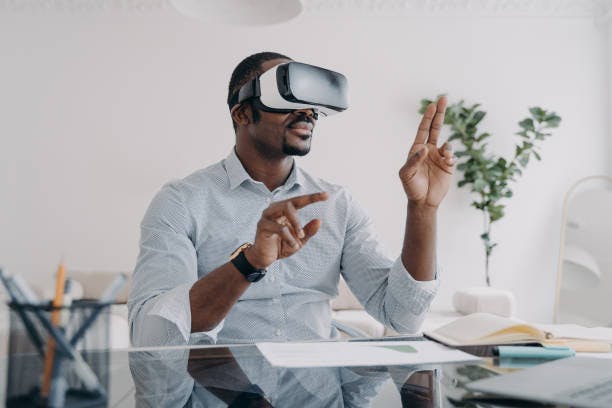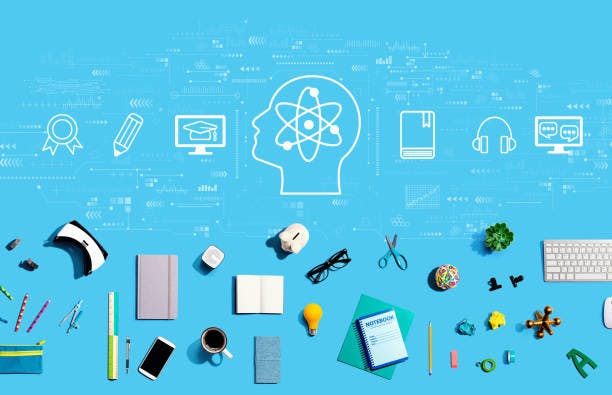14 March, 2025

 Marvellous Ihejiamaizu
Marvellous Ihejiamaizu04 October, 2024
Virtual Reality: Shaping the Future of Education
Welcome to the frontier of education, where Virtual Reality (VR) is revolutionizing the way we teach and learn. Let’s look at the world of VR, shall we?
VR is a technology that immerses users in computer-generated environments, allowing them to interact with and explore virtual worlds as if they were physically present. It typically involves wearing a headset that covers the eyes and sometimes includes hand controllers for interaction. It creates a sense of presence and immersion through techniques such as stereoscopic 3D rendering, head tracking, and spatial audio. It’s applicable across various industries like gaming, education, healthcare, and training to mention a few.
While VR offers exciting entertainment, learning, and simulation possibilities, it also faces challenges such as high costs, motion sickness, and the need for compelling content. Nonetheless, VR continues to evolve rapidly, with advancements in technology driving its growth and adoption.
In this comprehensive exploration, we journey through the intricate landscape of VR, from its mechanics to its benefits. We consider its evolution, the challenges confronting it, and outline the possibilities that lie ahead in the future of VR in Africa.
The Evolution of VR in Education
Although VR had existed since the 1960s, the term “virtual reality” was coined and introduced by Jaron Lanier in 1987, with his research and engineering efforts making significant contributions to the emerging VR industry. Another important link between early VR research and technological growth in the United States was the involvement of the DoD, NSF, and even NASA. These activities also promoted collaboration among the academic, military, and commercial sectors.
The evolution of VR in education can be grouped into three categories as outlined below:
1.Early Adaptations:
- VR's Nascent Integration into Educational Settings:
This nascent integration marks the initial steps toward leveraging VR technology for educational purposes, with potential applications ranging from virtual field trips to interactive simulations.
- Initial Experiments in Research Labs and Academic Institutions:
Research laboratories and academic institutions are at the forefront of experimenting with VR technology for various applications, including education, training, healthcare, and entertainment.
Through these initial experiments, researchers and educators aim to understand the strengths and limitations of VR, paving the way for future advancements and widespread adoption in diverse fields.
2.Technological Milestones:
- Breakthroughs in Hardware Development:
VR has witnessed significant breakthroughs in hardware development, transitioning from bulky, cumbersome headsets to sleek and immersive devices due to innovations in display technology, optics, and ergonomics. These advancements have made VR more accessible and appealing to a broader audience, driving its adoption across various industries and applications.
- Advancements in Software:
The evolution of software has played a pivotal role in the development of VR technology, particularly in the areas of 3D modeling, interactive environments, and educational applications.
Software tools and platforms have become more sophisticated, enabling the creation of realistic and immersive virtual worlds with enhanced graphics and interactivity. Educational applications of VR have expanded significantly, with developers creating interactive simulations, virtual laboratories, and immersive learning experiences to engage students and facilitate experiential learning.
3.Shift to Immersive Learning:
- Transition from Passive to Active Learning Methodologies:
There has been a noticeable shift in educational patterns from passive to active learning methodologies that enable students to engage actively in the learning process such as pairing students together during tasks, debates, etc. Traditional learning approaches, which often involve passive consumption of information, are giving way to more interactive and engaging methods.
- Emergence of VR as a Tool for Experiential and Inquiry-Based Learning:
VR has emerged as a powerful tool for facilitating experiential and inquiry-based learning. By immersing students in realistic simulations and interactive environments, VR enables hands-on exploration and experimentation. Students can engage in problem-solving activities, conduct virtual experiments, and explore complex concepts in a safe and controlled setting.
The Mechanics of VR in Learning

Image by Gorodenkoff on istock
To understand the magic of VR, we must first dissect its inner workings. From the hardware that powers immersive experiences to the software that brings virtual worlds to life, every component plays a crucial role in creating an engaging learning environment. Let's take a deep dive into the technology behind VR, exploring the nuts and bolts that drive this transformative educational tool.
1.Hardware Components:
- Headsets and Controllers: Headsets immerse learners in virtual environments by providing high-resolution displays and motion-tracking sensors. These devices come in various models, from standalone headsets to those tethered to computers, offering different levels of immersion and interactivity. Controllers allow users to interact with virtual environments, enabling actions such as grabbing objects, manipulating tools, or navigating through simulations. These input devices come in handheld controllers, gloves, or even full-body motion tracking systems, enhancing engagement and interactivity in VR learning experiences. Examples include; PlayStation VR, Oculus S by Meta, and Vive Controllers
- Accessories and Sensors: Depending on the specific learning scenario, additional accessories may be used to augment the VR experience. These can include haptic feedback devices for tactile sensations, omnidirectional treadmills for locomotion, or biometric sensors for tracking physiological responses.
2.Software Development:
- Creation of virtual and 3D environments: Software developers create virtual environments that replicate real-world or fictional settings where learning activities take place. These environments can range from historical landmarks and scientific simulations to interactive laboratories and immersive storytelling experiences. Examples; Unity, Unreal Engine.
- Interactive platforms: VR learning software incorporates interactive content to engage learners and promote active participation. This can include interactive objects, simulations, quizzes, puzzles, and games that encourage exploration, experimentation, and problem-solving. Examples; Google Expeditions, Nearpod VR, HoloLens.
- Content creation tools: These are tools that empower educators to create and customize VR learning content without requiring advanced programming skills. These content creation tools may include drag-and-drop interfaces, templates, and asset libraries for building virtual environments and interactive activities. Examples; CoSpaces Edu, Tilt Brush
3.Integration into Curricula:
- Subject Integration: VR is integrated across various subjects and disciplines, including STEM (Science, Technology, Engineering, and Mathematics), humanities, social sciences, arts, and vocational training offering immersive learning opportunities.
- Cross-Curricular Connections: VR experiences are designed to facilitate cross-curricular connections, allowing students to explore interdisciplinary concepts and themes. For example, a VR simulation of a historical event can incorporate elements of geography, literature, and social studies.
- Supplemental and Experiential Learning: VR is used as a supplement to traditional classroom instruction, providing students with experiential learning opportunities that complement theoretical concepts taught in textbooks or lectures. It allows students to virtually visit locations, conduct experiments, and engage in activities that may not be feasible in the physical classroom.
Conclusion
Virtual Reality is revolutionizing education by transforming how we teach and learn. From early experiments to today's advanced hardware and software, VR has evolved to offer immersive and interactive learning experiences. Despite challenges like high costs and content development, VR's educational potential is immense.
As technology advances and becomes more accessible, VR will continue to enhance and reshape educational experiences, making learning more engaging and effective. By embracing VR, we are paving the way for a more interactive and inclusive future in education.






